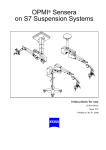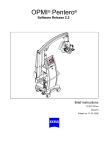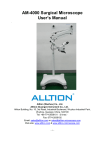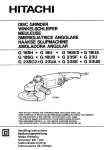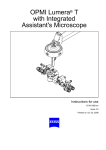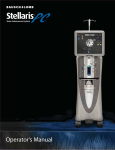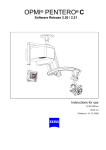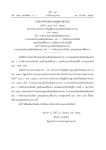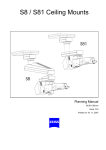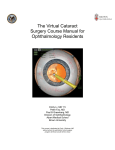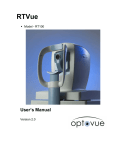Download Zeiss VISU 200 Technical data
Transcript
OPMI® VISU 200 BrightFlex™ Surgical Microscope Instructions for use G-30-1439-en Issue 3.0 Printed on 21. 11. 2002 Contents G-30-1439-en Functions at a glance 5 – VISU 200 BrightFlex™ surgical microscope 6 – Key to symbols 7 Safety 9 – Directives and standards 10 – Notes on installation and use 11 – When using a fundus imaging system (e.g. BIOM II) 14 – Phototoxic retinal injury in eye surgery 14 – Warning labels and notes 18 Description 19 VISU 200 BrightFlex™ Surgical Microscope 20 – Intended use 20 – Description of the modules 20 – Illumination system 28 – Controls, displays, connections 30 – Hand grips (option) 38 – Tube and eyepieces for main microscope 40 – Tube and eyepieces for assistant's microscope 42 Preparations for use 45 – Mounting the binocular tubes, eyepieces and the objective lens 46 Operation 49 Preparations for use 50 – Adjusting the tilt angle 50 – Setting the microscope tilt to angles greater than 15° 52 – Adjusting the surgical microscope 53 – Checklist 54 – When using a fundus imaging system (e.g. BIOM II) 56 OPMI® VISU 200 BrightFlex™ Surgical Microscope Issue 3.0 Printed on 21. 11. 2002 Procedure 57 What to do in an emergency 59 – Failure of zoom system 59 – Failure of X-Y coupling 60 – Failure of focusing system 60 Maintenance / Further information 61 – Trouble-shooting table 62 – Magnifications / Fields of view 64 – Care of the unit 65 – Sterilization 66 – Ordering data 67 – Spare parts 68 – Accessories 68 – Adapter cables 70 Technical data 71 – Technical data 72 – Ambient requirements 74 Index G-30-1439-en OPMI® VISU 200 BrightFlex™ Surgical Microscope 75 Issue 3.0 Printed on 21. 11. 2002 5 Functions at a glance Functions at a glance G-30-1439-en VISU 200 BrightFlex™ surgical microscope 6 Key to symbols 7 OPMI® VISU 200 BrightFlex™ Surgical Microscope Issue 3.0 Printed on 21. 11. 2002 6 Functions at a glance VISU 200 BrightFlex™ surgical microscope 1 Resetting the X-Y coupling, focus and zoom to their initial positions 2 Adjusting the tilt of the surgical microscope 3 Setting the interpupillary distance 4 Adjusting the eyecups 5 Setting your prescription 6 Display of the magnification factor of the zoom system 7 Setting the red reflex illumination (+2° and -2°) 8 Releasing the magnetic brakes of the suspension system 9 Changing the magnification on assistant's microscope 10 Focusing of assistant's microscope 11 Setting the 6° illumination 12 Arrows indicating the focusing range 13 14 15 16 Locking screw for assistant's microscope (vertical) Selecting light stops Connecting the light guide Locking screw for assistant's microscope (horizontal) Page 30 Page 50 Page 40 Page 40 Page 40 Page 32 Page 28 Page 32 Page 34 Page 34 Page 36 Pages 30, 56 Page 34 Page 36 Page 36 Page 36 1 2 3 4 5 6 7 G-30-1439-en 8 9 10 5 4 11 12 8 OPMI® VISU 200 BrightFlex™ Surgical Microscope 10 9 13 14 15 16 Issue 3.0 Printed on 21. 11. 2002 7 Functions at a glance Key to symbols Different symbols used in this user's manual draw your attention to safety aspects and useful tips. The symbols are explained in the following. Warning! The warning triangle indicates potential sources of danger which may constitute a risk of injury for the user or a health hazard. Caution: The square indicates situations which may lead to malfunction, defects, collision or damage of the instrument. Note: The hand indicates hints on the use of the instrument or other tips for the user. OPMI® G-30-1439-en OPMI® is a registered trademark of Carl Zeiss. OPMI® VISU 200 BrightFlex™ Surgical Microscope Issue 3.0 Printed on 21. 11. 2002 8 Functions at a glance G-30-1439-en OPMI® VISU 200 BrightFlex™ Surgical Microscope Issue 3.0 Printed on 21. 11. 2002 9 Safety Safety G-30-1439-en Directives and standards 10 Notes on installation and use 11 When using a fundus imaging system (e.g. BIOM II) 14 Phototoxic retinal injury in eye surgery 14 Warning labels and notes 18 OPMI® VISU 200 BrightFlex™ Surgical Microscope Issue 3.0 Printed on 21. 11. 2002 10 Safety The instrument described in this manual has been developed and tested in accordance with Carl Zeiss safety standards and with national and international regulations. A high degree of instrument safety is thus ensured. We would like to inform you on the safety aspects involved in operating the instrument. This chapter contains a summary of the most important precautions to be observed. Further safety notes are also contained in other parts of this user's manual; they are marked with a warning triangle containing an exclamation mark as shown here. Please pay special attention to these safety notes. Safety is only ensured when this instrument is operated properly. Please read through this manual carefully before turning the instrument on. Also read through the user's manuals of the other equipment used with this instrument. You may obtain further information from our service organization or authorized representatives. Directives and standards The instrument described in this manual has been designed in compliance with the following standards: – EN – IEC – UL – CSA In accordance with Directive 93/42/EEC, the complete quality management system of the company Carl Zeiss has been certified by the DQS Deutsche Gesellschaft zur Zertifizierung von Managementsystemen mbH, a notified body, under registration number 250758 MR2. G-30-1439-en • The instrument must be connected to a special emergency backup line supply in accordance with the regulations or directives which apply in your country. • This is a class I instrument as defined by Directive 93/42 /EEC. • Please observe all applicable accident prevention regulations. OPMI® VISU 200 BrightFlex™ Surgical Microscope Issue 3.0 Printed on 21. 11. 2002 11 Safety Notes on installation and use Safe working order • G-30-1439-en Do not operate the equipment contained in the delivery package in – explosion-risk areas, – the presence of inflammable anesthetics or volatile solvents such as alcohol, benzine or similar chemicals. • Do not station or use the instrument in damp rooms. Do not expose the instrument to water splashes, dripping water or sprayed water. • Immediately unplug any equipment that gives off smoke, sparks or strange noises. Do not use the instrument until our service representative has repaired it. • Do not place any fluid-filled containers on top of the instrument. Make sure that no fluids can seep into the instrument. • Do not force cable connections. If the male and female parts do not readily connect, make sure that they are appropriate for one another. If any of the connectors are damaged, have our service representative repair them. • Potential equalization: The instrument can be incorporated into potential equalization measures. For this purpose, contact our service department. • Do not use a mobile phone in the vicinity of the equipment because the radio interference can cause the equipment to malfunction. The effects of radio interference on medical equipment depend on a number of various factors and are therefore entirely unforeseeable. • Modifications and repairs on these instruments or instruments used with them may only be performed by our service representative or by other authorized persons. • The manufacturer will not accept any liability for damage caused by unauthorized persons tampering with the instrument; this will also forfeit any rights to claim under warranty. • Use this instrument only for the applications described. • Only use the instrument with the accessories supplied. Should you wish to use other accessory equipment, make sure that Carl Zeiss or the equipment manufacturer has certified that its use will not impair the safety of instrument. OPMI® VISU 200 BrightFlex™ Surgical Microscope Issue 3.0 Printed on 21. 11. 2002 12 Safety • Only personnel who have undergone training and instruction are allowed to use this instrument. It is the responsibility of the customer or institution operating the equipment to train and instruct all staff using the equipment. • Keep the user's manuals where they are easily accessible at all times for the persons operating the instrument. • Never look at the sun through the binocular tube, the objective lens or an eyepiece. • Do not pull at the light guide cable, at the power cord or at other cable connections. • This instrument is a high-grade technological product. To ensure optimum performance and safe working order of the instrument, its safety must be checked once every 12 months. We recommend having this check performed by our service representative as part of regular maintenance work. If a failure occurs which you cannot correct using the trouble-shooting table, attach a sign to the instrument stating it is out of order and contact our service representative. Requirements for operation Our service representative or a specialist authorized by us will install the instrument. Please make sure that the following requirements for operation remain fulfilled in the future: – All mechanical connections (details in the user's manual) which are relevant to safety are properly connected and screw connections tightened. – All cables and plugs are in good working condition. – The voltage setting on the instrument conforms to the rated voltage of the line supply on site. – The instrument is plugged into a power outlet which has a properly connected protective earth contact. – The power cord being used is the one designed for use with this instrument. Before every use and after re-equipping the instrument G-30-1439-en • Make sure that all ”Requirements for operation” are fulfilled. • Go through the checklist. • Re-attach or close any covers, panels or caps which have been removed or opened. OPMI® VISU 200 BrightFlex™ Surgical Microscope Issue 3.0 Printed on 21. 11. 2002 13 Safety • Pay special attention to warning symbols on the instrument (triangular warning signs with exclamation marks), labels and any parts such as screws or surfaces painted red. For every use of the instrument G-30-1439-en • Avoid looking directly into the light source, e.g. into the microscope objective lens or a light guide. • Any kind of radiation has a detrimental effect on biological tissue.This also applies to the light illuminating the surgical field. Please therefore reduce the brightness and duration of illumination on the surgical field to the absolute minimum required. • When operating on the eye, always use a GG 475 protection filter to ensure that the patient's retina is not exposed to unnecessary (blue) radiation (retinal injury). OPMI® VISU 200 BrightFlex™ Surgical Microscope Issue 3.0 Printed on 21. 11. 2002 14 Safety When using a fundus imaging system (e.g. BIOM II) When using a fundus imaging system (e.g. BIOM II from the company Oculus) which is usually installed between the surgical microscope and the patient, make sure that the patient is neither put at risk nor injured by the motorized focusing system or the movement of the stand arm. Only use accessories expressly certified by the manufacturer for combination with the surgical microscope described in this manual. Caution! Risk of collision! 1 • With the fundus imaging system swung out of position, always position the microscope body in such a way that index dot (1) of the microscope's focus is in the middle of triangle (2) of the marking. • Select a medium magnification (e.g. 1.0). • Lower the surgical microscope towards the surgical field until you see the patient's cornea sharply defined. • Turn the screw for limiting the downward movement clockwise as far as it will go. • It is vital that you read the user’s manual on the fundus imaging system (e.g. BIOM II from the company Oculus). 2 Phototoxic retinal injury in eye surgery General Several papers have been published dealing with the problems of phototoxicity during eye surgery. A comprehensive review of these publications reveals five aspects of particular concern: G-30-1439-en – Illumination characteristics (spectral composition) – Intensity of illumination – Angle of illumination – Focus of the light source – Exposure time to light OPMI® VISU 200 BrightFlex™ Surgical Microscope Issue 3.0 Printed on 21. 11. 2002 15 Safety In the following, comments on these aspects are given and a description of how Carl Zeiss, as a manufacturer, makes allowance for them in its instruments. Illumination characteristics (spectral composition) Studies on exposure of the eye to light of varying spectral composition date back to the early 1950s. These studies suggest that the potential hazard of phototoxic injury to the patient's retina can be reduced by blocking out the blue and ultraviolet light below a wavelength of 475 nm. Carl Zeiss provides a GG 475 retina protection filter for surgical microscopes recommended for use in ophthalmic surgery. This reduces not only the light exposure of the patient's eye, but also that of the surgeon's. It should be noted in this context that the use of filters inevitably leads to a change in the color of the light. The surgeon may therefore have to get used to the changed appearance of anatomical structures. Intensity of illumination The majority of researchers suggest that the surgeon should use the lowest light intensity necessary to guarantee good viewing during surgery. Carl Zeiss has addressed this concern by providing a device for continuously varying the brightness of the light source. This permits the surgeon to optimally adapt the light intensity at the patient's eye to the conditions existing in each case. Carl Zeiss strongly discourages the use of xenon or other high-intensity light sources in ophthalmology. Angle of illumination A number of publications suggest that the microscope should be tilted to reduce the exposure of the macula to direct illumination. Carl Zeiss ophthalmic surgical microscopes are therefore equipped with the following: – Tilting mechanism for the microscope body – Oblique illumination with brightness control Focus of the light source Studies show that injuries are likely to occur if the filament of the light source is imaged on the patient's retina. The peak intensity of a filament is considerably higher than the peak intensity of an even and extended light source such as a fiber guide. G-30-1439-en OPMI® VISU 200 BrightFlex™ Surgical Microscope Issue 3.0 Printed on 21. 11. 2002 16 Safety This is the reason why fiber optic illumination is used in surgical microscopes from Carl Zeiss. Exposure time to light According to some publications, the phakic or aphakic eye should not be exposed to the light source longer than a few minutes. In every operation the exposure of the retina to light is dependent on the type and duration of surgery and on any complications which occur. It is therefore recommended in ophthalmic surgery to keep the light intensity as low as possible, or to use a device which prevents the light from entering through the patient's pupil. Also, the surrounding light sources should not cause additional strain to the patient's eye. Carl Zeiss has provided an answer to this problem in the form of a swingin retinal protection device for insertion into the beam path of the surgical microscope. This device ensures total eclipsing of the pupil, preventing light from entering into the patient's eye. It can be swung out when a red reflex is required. Intensity scale The intensity scale of our suspension system is calibrated in units of the ”Spectrally weighted radiance for the photochemical hazard of the phakic eye (LB)” LB is the spectral radiance integrated over the spectral range from 380 nm to 700 nm and weighted with B(λ): 700 LB = ∑ L(λ) B(λ) ∆λ 380 in which B(λ) is the spectral weighting function for the photochemical hazard of the retina of the phakic eye. The value LB = 500mW/cm² sr is the reference value and is defined as 1.0 on the intensity scale of the suspension system as recommended in the ISO 10936-2 standard draft for surgical microscopes used in ophthalmic applications. At this reference value, photoretinitis might be expected to occur from the surgical microscope light source in a total retinal exposure time of 10 minutes. This applies to the exposure of a specific point on the retina with an uninterrupted illumination beam. In a cataract procedure, instruments such as the phacoemulsification handpiece, the G-30-1439-en OPMI® VISU 200 BrightFlex™ Surgical Microscope Issue 3.0 Printed on 21. 11. 2002 17 Safety use of fluids in the eye, manipulation and movement of the eye, among other factors, result in the interruption of the illumination from the surgical microscope light source. Such factors would be expected to significantly extend the time at which photoretinitis might occur. In conclusion Carl Zeiss recommends: – Use of the GG 475 eye protection filter. – Reduction of the illumination of the surgical area to the extent required for the patient's safety and for microscopic visualization. – Tilting of the microscope body as required. – Insertion of the retinal protection device. – Maximum reduction of the exposure of the patient's eye to light from surrounding light sources. These measures should help the surgeon to reduce the likelihood of phototoxic retinal injury. Note: The VISU 150 microscope always contains a UV blocking filter. The use of this filter ensures that the illumination intensity lies below 50 µW/cm2 in the range between 305 nm and 400 nm. These measures help the surgeon to reduce the risk of phototoxic retinal injury. G-30-1439-en OPMI® VISU 200 BrightFlex™ Surgical Microscope Issue 3.0 Printed on 21. 11. 2002 18 Safety Warning labels and notes Caution: Observe all warning labels and notes! If any label is missing on your instrument or has become illegible, please contact us or one of our authorized representatives. We will supply the missing labels. G-30-1439-en OPMI® VISU 200 BrightFlex™ Surgical Microscope Issue 3.0 Printed on 21. 11. 2002 Description 19 VISU 200 BrightFlex™ Surgical Microscope 20 Intended use 20 Description of the modules 20 Illumination system 28 Controls, displays, connections 30 Hand grips (option) 38 Tube and eyepieces for main microscope 40 Tube and eyepieces for assistant's microscope 42 Description G-30-1439-en OPMI® VISU 200 BrightFlex™ Surgical Microscope Issue 3.0 Printed on 21. 11. 2002 20 Description VISU 200 BrightFlex™ Surgical Microscope Intended use The VISU 200 BrightFlex™ surgical microscope has been designed for surgical procedures in the field of ophthalmology, i.e. the microscope meets the special requirements of this discipline. Description of the modules The VISU surgical microscope is comprised of the following modules: 1 X-Y coupling The X-Y coupling allows fine, motorized positioning of the surgical microscope in a horizontal plane. The range of travel is 40 mm x 40 mm. The speed of travel can be set on the display field of the suspension system. The X-Y coupling is provided with a recentering mechanism. When you press the actuator button, – the X-Y coupling adopts its center position, – the focusing system of the surgical microscope is reset to its initial position and – the zoom system will set a preselected magnification factor if the XYZ-RES function has been activated (possible with S8 suspension systems only). You can also trigger the recentering movement using the foot control panel.. G-30-1439-en OPMI® VISU 200 BrightFlex™ Surgical Microscope Issue 3.0 Printed on 21. 11. 2002 21 Description 1 G-30-1439-en OPMI® VISU 200 BrightFlex™ Surgical Microscope Issue 3.0 Printed on 21. 11. 2002 22 Description 2 Support arm for the surgical microscope The support arm incorporates a tilt device. This allows the viewing direction of the surgical microscope to be adapted to the requirements of the surgical field. Using the knob for fine tilt, you can position the surgical microscope in a range from +180° to -180° (+ in the direction of the surgeon and - in the opposite direction). The +90° setting is ideal for surgery on patients in a seated position or lying on their side. Caution: Do not tilt the main microscope beyond + / - 180°, as this could damage the microscope cable or the light guide. 3 Main microscope The apochromatic optics of the main microscope provide superb optical quality. The microscope image displays optimum contrast and excellent detail recognition along with a large depth of field. The bright microscope image is a particular benefit in vitreoretinal surgery. A 1:6 ratio zoom system allows the magnification of the overall system to be set as required by the surgical procedure. Two apochromatic objective lenses with focal lengths of 175 mm and 200 mm are available for different working distances. A 180° tiltable tube is used as a viewing device for the surgeon. The large tilt range allows work with minimum fatigue. The standard equipment includes eyepieces with a magnification factor of 12.5x (option: 10x). The illumination system has been designed for use in ophthalmology. A light guide directs the light from the light source in the suspension system to the surgical microscope. 6° illumination can be continuously faded in. This allows the illumination intensity in the surgical field to be adjusted continuously, without changing the color of the light. The illumination of the surgical field at an angle of 6° produces an image with an outstanding impression of depth. An additional illumination system produces an intensive red reflex even when the eye is decentered. The angle of illumination can be switched from +2° to -2°. G-30-1439-en OPMI® VISU 200 BrightFlex™ Surgical Microscope Issue 3.0 Printed on 21. 11. 2002 23 Description 2 3 G-30-1439-en OPMI® VISU 200 BrightFlex™ Surgical Microscope Issue 3.0 Printed on 21. 11. 2002 24 Description To protect the patient's eye against photo-retinitis, a retinal protection device is provided. This device can be swung into the illumination beam path, if no red reflex is required. At the light source integrated in the stand, a GG 475 eye protection filter can be swung into the illumination beam path. This filter markedly reduces the exposure of the patient's and surgeon's eyes to radiation. A video camera from our MediLive video camera line can be optionally connected to the VISU 200 surgical microscope. The light loss for the surgeon is only 20% and cannot be perceived subjectively. Caution! G-30-1439-en – Avoid looking directly into the light source, e.g. into the microscope objective lens or into the light guide! – When selecting the brightness level for the patient's eye, always take care to keep the strain on the patient's eye to a minimum. – If the red reflex is not necessary, move the retinal protection device into the beam path. Only use the retro-illumination contrast stop, if the surgical procedure requires a red reflex. – When operating on the eye, always use a GG 475 eye protection filter to ensure that the patient's retina is not exposed to unnecessary (blue) radiation (retinal injury)! OPMI® VISU 200 BrightFlex™ Surgical Microscope Issue 3.0 Printed on 21. 11. 2002 25 Description G-30-1439-en OPMI® VISU 200 BrightFlex™ Surgical Microscope Issue 3.0 Printed on 21. 11. 2002 26 Description 4 0° assistant's microscope The assistant's microscope is an integral part of the VISU 200 BrightFlex™ surgical microscope, i.e. it cannot be separated from the main microscope. The assistant sees the same image as the main surgeon. The system's excellent image quality is also available to the assistant. The assistant's microscope has two working positions. They are located on the right and left of the main surgeon at an angle of 90° to the main surgeon's viewing direction. No locking mechanism has been provided, allowing the assistant to move the microscope by a certain amount out of the 90° position, if necessary. Warning! To prevent the assistant's microscope from moving downward of its own accord when the main microscope is being tilted, the assistant's microscope must be adjusted and locked in position using screw (5) before surgery. The assistant's microscope is equipped with a focusing system and a 5-step magnification changer. This enables the assistant to adjust his microscope image independently of the main surgeon. The binocular tube can be turned by ± 12° about the optical axis of the assistant's microscope. In addition, the assistant's microscope can be tilted by 15°. If the assistant finds the viewing angle too steep, an optical wedge (option) can be installed between the microscope body and the binocular tube to permit horizontal viewing. The standard equipment includes eyepieces with a magnification factor of 10x, providing a low initial magnification. This provides the benefit of a wide field of view and an improved overview of the surgical field. The assistant sees the red reflex in both eyepieces. 5 G-30-1439-en Locking screw for assistant's microscope After adjusting the assistant's microscope as required, secure it in position using this screw. OPMI® VISU 200 BrightFlex™ Surgical Microscope Issue 3.0 Printed on 21. 11. 2002 27 Description 4 5 G-30-1439-en OPMI® VISU 200 BrightFlex™ Surgical Microscope Issue 3.0 Printed on 21. 11. 2002 28 Description Illumination system 6° illumination You can continuously fade out the 6° illumination. This results in markedly reduced reflection from the cornea, while providing nevertheless a highcontrast, informative microscope image. For cataract surgery, we recommend opening the 6° illumination system approx. 25%. 2° illumination You can switch the illumination from +2° to -2°. This ensures good visibility of the red reflex even when the patient's eye is decentered. 1 2 6° illumination and 2° illumination 2° illumination with centered patient's eye Here, the red reflex is clearly visible in both positions (+2° and -2°). 3 2° illumination with decentered patient's eye The red reflex is no longer visible at +2°. After switching to -2°, the red reflex is again clearly visible. + 6° - 2° G-30-1439-en + 2° OPMI® VISU 200 BrightFlex™ Surgical Microscope Issue 3.0 Printed on 21. 11. 2002 29 Description 1 2 G-30-1439-en 3 OPMI® VISU 200 BrightFlex™ Surgical Microscope Issue 3.0 Printed on 21. 11. 2002 30 Description Controls, displays, connections 1 Instrument connector 2 Microscope shaft 3 X-Y coupling 4 Actuator button – recenters the X-Y coupling. – resets the focus to its initial position in the focusing range, and – the zoom system will set a preselected magnification factor if the XYZ-RES function has been activated (possible with S8 suspension systems only). Note: Press this button to start the recentering movement. To stop this movement, press the button again. You can also stop the recentering movement by briefly tipping on one of the direction keys on the foot control panel. G-30-1439-en 5 Cable and light guide clip 6 Support arm with tilt device 7 Knob for setting the tilt angle of the surgical microscope; +180° in the direction of the surgeon, -180° in the opposite direction. 8 Arrows indicating the focusing range OPMI® VISU 200 BrightFlex™ Surgical Microscope Issue 3.0 Printed on 21. 11. 2002 31 Description 1 2 3 4 5 6 7 8 G-30-1439-en OPMI® VISU 200 BrightFlex™ Surgical Microscope Issue 3.0 Printed on 21. 11. 2002 32 Description 9 Dust cover 10 Release buttons for the magnetic brakes of the stand Only in connection with suspension systems with magnetric brakes. A second button with the same function is located on the opposite side in the knob for the additional red reflex illumination. – Button pressed magnetic brakes are released, the unit can be moved as required. – Button released magnetic brakes are locked, the unit cannot be moved. 11 Maneuvering grip including release button. See (10). 12 Display of the magnification factor of the zoom system 13 Securing screw G-30-1439-en OPMI® VISU 200 BrightFlex™ Surgical Microscope Issue 3.0 Printed on 21. 11. 2002 33 Description 9 10 11 G-30-1439-en 12 13 OPMI® VISU 200 BrightFlex™ Surgical Microscope Issue 3.0 Printed on 21. 11. 2002 34 Description 14 Manual adjustment of zoom system 15 Knob for adjusting the red reflex illumination The angle of illumination can be switched between + 2° and - 2°. 16 Release button for magnetic brakes (A second button with the same function is located in maneuvering grip (10). – Button pressed magnetic brakes are released, the unit can be moved as required. – Button released magnetic brakes are locked, the unit cannot be moved. 17 Securing screw for locking the assistant's tube within its 12° range of movement. 18 Binocular tube of the assistant's microscope 19 Focusing knob for adjusting the assistant's microscope independently of the main surgeon. 20 Five-step manual magnification changer 21 Screw for locking the assistant's microscope within its 15° tilt range. G-30-1439-en OPMI® VISU 200 BrightFlex™ Surgical Microscope Issue 3.0 Printed on 21. 11. 2002 35 Description 14 15 16 17 18 19 20 G-30-1439-en 21 OPMI® VISU 200 BrightFlex™ Surgical Microscope Issue 3.0 Printed on 21. 11. 2002 36 Description 22 Light stop knob Retro-illumination contrast stop. This stop reduces the straylight reflected from the sclera. Diameter approx. 16 mm (with objective lens f = 200 mm): Free passage. Diameter over approx. 16 mm: Partially transmitting periphery. Free passage. The field of view is fully illuminated. Retinal protection device. This device does not snap in, i.e. it can be moved continuously in the image. 23 Adjusting lever for the 6° illumination for gradual fading in/out the coaxial illumination. Fading out the 6° illumination improves the visualization of structures in retro-illumination. 24 Connector socket for S light guide 25 Locking screw for assistant's microscope for locking the assistant's microscope in both working positions on the right and left of the main microscope. Warning! To prevent the assistant's microscope from moving downward of its own accord when the main microscope is being tilted, the assistant's microscope must be adjusted and locked in position using screw (25) before surgery. G-30-1439-en OPMI® VISU 200 BrightFlex™ Surgical Microscope Issue 3.0 Printed on 21. 11. 2002 37 Description 22 G-30-1439-en 23 OPMI® VISU 200 BrightFlex™ Surgical Microscope 24 25 Issue 3.0 Printed on 21. 11. 2002 38 Description Hand grips (option) In addition to the maneuvering grips provided, larger hand grips can be mounted. The mounting procedure is described in the instructions enclosed. This does not affect the functioning of the surgical microscope. Only the operation of the surgical microscope is slightly changed. 1 2 G-30-1439-en Maneuvering grip with integrated release button By turning one of the two maneuvering grips you will activate the button for magnetic brakes of the suspension system. (Only in combination with suspension systems with magnetic brakes (e.g. S8 Floor Stand)). – Button pressed Magnetic brakes are released, the unit can be moved as required. – Button released Magnetic brakes are locked, the unit cannot be moved. Knob for adjusting the red reflex illumination By sliding the knob, you can switch the angle of illumination between + 2° and - 2°. OPMI® VISU 200 BrightFlex™ Surgical Microscope Issue 3.0 Printed on 21. 11. 2002 39 Description 1 2 1 G-30-1439-en OPMI® VISU 200 BrightFlex™ Surgical Microscope Issue 3.0 Printed on 21. 11. 2002 40 Description Tube and eyepieces for main microscope G-30-1439-en 1 180° tiltable tube 2 PD adjustment knob The correct interpupillary distance has been set when both eyepiece images merge into one. 3 Push-in widefield eyepiece Note: When you remove the eyepiece from the tube, please note that this eyepiece is fitted with a magnetic coupling. When mounted, the eyepieces display a very weak magnetic field. For this reason, the usual rules for the handling of magnets must only be observed with eyepieces which have not been mounted on the microscope: • Do not place the eyepieces close to instruments where there is any risk of magnetization. • Do not place eyepieces on sensitive electronic instruments such as infusion pumps, cardiac pace-makers, measuring instruments or magnetic data carriers such as disks, audiotapes and videotapes or credit cards. • Always store the eyepieces in their original packaging when not in use. 4 Eyecup Always adjust the eyecups in such a way that you can see the full field of view. – Viewing with eyeglasses: Screw in eyecups all the way. – Viewing without eyeglasses: Screw eyecups outward until you can see the full field of view. 5 Diopter setting ring The eyepieces provide ametropia compensation from -8 D to +5 D. If you wear your eyeglasses during work, adjust the ring to 0 D. Turn the ring until you have found the optimum setting. A built-in catch lever locks the ring in the position set. 6 Diopter scale For reading the prescription set. OPMI® VISU 200 BrightFlex™ Surgical Microscope Issue 3.0 Printed on 21. 11. 2002 41 Description 1 2 3 4 5 6 G-30-1439-en OPMI® VISU 200 BrightFlex™ Surgical Microscope Issue 3.0 Printed on 21. 11. 2002 42 Description Tube and eyepieces for assistant's microscope 7 Push-in widefield eyepiece Note: When you remove the eyepiece from the tube, please note that this eyepiece is fitted with a magnetic coupling. When mounted, the eyepieces display a very weak magnetic field. For this reason, the usual rules for the handling of magnets must only be observed with eyepieces which have not been mounted on the microscope: • Do not place the eyepieces close to instruments where there is any risk of magnetization. • Do not place eyepieces on sensitive electronic instruments such as infusion pumps, cardiac pace-makers, measuring instruments or magnetic data carriers such as disks, audiotapes and videotapes or credit cards. • Always store the eyepieces in their original packaging when not in use. 8 Eyecup Always adjust the eyecups in such a way that you can see the full field of view. 9 – Viewing with eyeglass- Screw in eyecups all the way. es: – Viewing w/out eyeglass- Screw eyecups outward until you see es: the full field of view. Diopter scale For reading the prescription set. 10 Diopter setting ring The eyepieces provide ametropia compensation from -8 D to +5 D.If you wear your eyeglasses during work, adjust the ring to 0 D. Turn the ring until you have found the optimum setting. A built-in catch lever locks the ring in the position set. 11 Binocular assistant's microscope Note: Always use the assistant's microscope with the appropriate (shown) binocular assistant's tube. If you use a different tube, you will obtain an inverted image. G-30-1439-en OPMI® VISU 200 BrightFlex™ Surgical Microscope Issue 3.0 Printed on 21. 11. 2002 43 Description 7 8 9 10 11 G-30-1439-en OPMI® VISU 200 BrightFlex™ Surgical Microscope Issue 3.0 Printed on 21. 11. 2002 44 Description G-30-1439-en OPMI® VISU 200 BrightFlex™ Surgical Microscope Issue 3.0 Printed on 21. 11. 2002 45 Preparations for use Preparations for use Mounting the binocular tubes, eyepieces and the objective lens G-30-1439-en OPMI® VISU 200 BrightFlex™ Surgical Microscope Issue 3.0 Printed on 21. 11. 2002 46 46 Preparations for use Mounting the binocular tubes, eyepieces and the objective lens Note: Always use the assistant's microscope with the appropriate binocular assistant's tube (shown). If you use a different tube, you will obtain an inverted image. • Loosen securing screw (5) by a few turns. • Remove cover (1) and store it in a safe place. • Place binocular tube (2) on the surgical microscope and tighten securing screw (5) firmly. • You can install other units between the binocular tube and the microscope body. Lock these units in position in the same way using securing screw (5). • Place binocular tube (10) on the assistant's microscope and tighten securing screw (7)firmly. • You can install other units between the binocular tube and the microscope body (e.g. an optical wedge, 30°). Lock these units in position in the same way using securing screw (7). • Insert 12.5x widefield eyepieces (4) into the mounts intended for them (3) as far as they will go. The magnetic coupling reliably secures them in position. • Insert 10x widefield eyepieces (9) into the mounts intended for them (8) as far as they will go. The magnetic coupling reliably secures them in position. Note: If a documentation device is used, one of the eyepieces can be delivered with a reticle to aid focusing. Retrofitting the reticle can only be performed at the factory or by our service representative. Always use the eyepiece with reticle on the same side of the binocular tube as the documentation device is installed. • G-30-1439-en Screw objective lens (6) into the microscope body and tighten itfirmly. OPMI® VISU 200 BrightFlex™ Surgical Microscope Issue 3.0 Printed on 21. 11. 2002 47 Preparations for use Caution: Before using and after re-equipping the unit, make sure that the two binocular tubes (2 and 10) are securely locked in position. Make sure that – securing screws (5 and 7) and – objective lens (6) have been tightened firmly. 1 2 3 10 4 9 8 5 7 6 G-30-1439-en OPMI® VISU 200 BrightFlex™ Surgical Microscope Issue 3.0 Printed on 21. 11. 2002 48 Preparations for use G-30-1439-en OPMI® VISU 200 BrightFlex™ Surgical Microscope Issue 3.0 Printed on 21. 11. 2002 Operation 49 Preparations for use 50 Adjusting the tilt angle 50 Setting the microscope tilt to angles greater than 15° 52 Adjusting the surgical microscope 53 Checklist 54 When using a fundus imaging system (e.g. BIOM II) 56 Procedure 57 What to do in an emergency 59 Failure of zoom system 59 Failure of X-Y coupling 60 Failure of focusing system 60 Operation G-30-1439-en OPMI® VISU 200 BrightFlex™ Surgical Microscope Issue 3.0 Printed on 21. 11. 2002 50 Operation Preparations for use Adjusting the tilt angle Using knob (1), you can position the surgical microscope in a range from +180° to -180° (+ in the direction of the surgeon and - in the opposite direction). The +90° setting is ideal for surgery on patients in a seated position or lying on their side. Warning! – To prevent the assistant's microscope from moving downward of its own accord when the main microscope is being tilted, the assistant's microscope must be adjusted and locked in position using screw (2) before surgery. – Check that the assistant's microscope is firmly seated. – Do not tilt the main microscope beyond + / - 180°, as this could damage the microscope cable or the light guide. • Using locking screw (2), secure the assistant's microscope in the working position set (on the left or right of the main microscope). • Turn knob (1) until the surgical microscope is in the viewing position required. After the viewing angle has been set, the surgical microscope remains in this position. The gear drive is self-locking. G-30-1439-en OPMI® VISU 200 BrightFlex™ Surgical Microscope Issue 3.0 Printed on 21. 11. 2002 51 Operation 1 2 G-30-1439-en OPMI® VISU 200 BrightFlex™ Surgical Microscope Issue 3.0 Printed on 21. 11. 2002 52 Operation Setting the microscope tilt to angles greater than 15° • Using locking screw (2), secure the assistant's microscope in the working position set (on the left or right of the main microscope). • Check that the assistant's microscope is firmly seated. • Remove the binocular tube and all accessories mounted on the assistant's microscope. • Remove all accessories mounted on the objective lens (e.g. 0° or 8° assistant's microscope). • Turn knob (1) until the surgical microscope is in the viewing position required. After the viewing angle has been set, the surgical microscope remains in this position. The gear drive is self-locking. 2 1 G-30-1439-en OPMI® VISU 200 BrightFlex™ Surgical Microscope Issue 3.0 Printed on 21. 11. 2002 53 Operation Adjusting the surgical microscope Bring the surgical microscope into starting position within the focusing range. Set the minimum magnification on the surgical microscope. Bring the surgical microscope into working position. Adjust the interpupillary distance on the binocular tube. Set the diopter scales on the eyepieces. Please note that instrument myopia may occur. Eyepieces with reticles: Eyepieces without reticles: Emmetropes set the diopter scale to 0 diopter (D). Eyeglass wearers (who perform surgery wearing their glasses) set the diopter scale to 0 diopter (D). Ametropes (who know their refractive powers and perform surgery without wearing their glasses) set the diopter scale ring to their refractive powers. Ametropes (who do not know their refractive powers and perform surgery without wearing their glasses): Set both eyepieces on the main microscope to +5 D. Set both eyepieces on the assistant’s microscope to +5 D (if applicable). Set both eyepieces on the main microscope to +5 D. Set both eyepieces on the assistant’s microscope to +5 D (if applicable). Remove the binocular tube and eyepieces from the microscope body and point them at a distant object*) , i.e. use them like a pair of binoculars.The image of the object is still unsharp. Turn the diopter scale ring on the eyepiece slowly clockwise until the reticle is imaged sharply. Stop turning the ring. Turn the diopter scale ring of one eyepiece slowly clockwise until the image of the object is sharp. Stop turning the ring. If necessary, repeat this procedure three times and take the average of the readings found. Adjust the second eyepiece in the same manner. Focus the surgical microscope on the object. The reticle and the object must be imaged sharply at the same time. Replace the tube and eyepieces on the microscope body and firmly tighten the securing screw. Adjust the second eyepiece in the same way until the object is seen sharply. Adjust the eyecups in such a way that the full field of view can be seen. Set the maximum magnification on the microscope and focus on the object. Set the working magnification required. When the magnification is changed, the focal plane is retained, but the depth of field changes. Note: If several surgeons use the instrument, it is advisable to draw up a table showing the individual refractive powers of each surgeon and to keep it in a handy location near the instrument. *) CAUTION: Never point the eyepieces at the sun! G-30-1439-en OPMI® VISU 200 BrightFlex™ Surgical Microscope Issue 3.0 Printed on 21. 11. 2002 54 Operation Checklist Always check the following points before surgery (without the patient!): VISU 200 BrightFlex™ surgical microscope – Check that the correct rated voltage has been set for the suspension system. – Check that all cables have been connected. – Check that the light guide has been connected. • Turn on the instrument at the power switch of the suspension system. Note: After the system has been switched on, the S8 suspension system(ophthalmology) automatically performs a self-test. The self-test is completed after approx. five seconds. Zoom – Check this function using the appropriate key on the foot control panel. Focus – Check this function using the appropriate key on the foot control panel. Friction adjustment of the surgical microscope – Check that the friction of the surgical microscope's rotation has been adjusted as required using the friction adjustment knob on the suspension system. Locking the assistant's microscope in position – Check that the assistant's microscope is locked in the working position required (on the right or left of the main microscope). Speeds of the surgical microscope's functions (only in connection with S8 suspension system (ophthalmology)) – Check that the speeds of the microscope's functions have been set as required on the S8 suspension system (ophthalmology). Eyepieces / Tiltable binocular tubes – Check that the tiltable tube of the main microscope and the assistant's microscope are in positions convenient for you. G-30-1439-en – Check that the correct interpupillary distance has been set. – Check that the eyecups have been adjusted in such a way that you can see the full field of view. – Check that the correct prescription has been set on the diopter scale. OPMI® VISU 200 BrightFlex™ Surgical Microscope Issue 3.0 Printed on 21. 11. 2002 55 Operation – Check that image quality is the same throughout the entire magnification range. Accessories – Using the relevant user's manuals, check that the other equipment (illumination system, video system, etc.) is working properly. Warning! If a function fails, you must not use this instrument for safety reasons. Correct the fault (see the "Troubleshooting table“) or contact our service dept. G-30-1439-en OPMI® VISU 200 BrightFlex™ Surgical Microscope Issue 3.0 Printed on 21. 11. 2002 56 Operation When using a fundus imaging system (e.g. BIOM II) When using a fundus imaging system (e.g. BIOM II from the company Oculus) which is usually installed between the surgical microscope and the patient, make sure that the patient is neither put at risk nor injured by the motorized focusing system or the movement of the stand arm. Only use accessories expressly certified by the manufacturer for combination with the surgical microscope described in this manual. Caution! Risk of collision! 1 • With the fundus imaging system swung out of position, always position the microscope body in such a way that index dot (1) of the microscope's focus is in the middle of triangle (2) of the marking. • Select a medium magnification (e.g. 1.0). • Lower the surgical microscope towards the surgical field until you see the patient's cornea sharply defined. • Turn the screw for limiting the downward movement clockwise as far as it will go. • It is vital that you read the user’s manual on the fundus imaging system (e.g. BIOM II from the company Oculus). 2 G-30-1439-en OPMI® VISU 200 BrightFlex™ Surgical Microscope Issue 3.0 Printed on 21. 11. 2002 57 Operation Procedure G-30-1439-en • Turn on the power switch of the suspension system. • Adjust the brightness of the surgical field illumination as required on the stand. • Check the unit using the checklist. • Move the surgical microscope over the surgical field and bring it into a convenient position within the working distance. • Press the activator button. – The X-Y coupling is recentered. – The focus is reset to its initial position in the focusing range. • Select the lowest magnification (zoom function on the foot control panel). • For coarse focusing, look through the eyepieces and lower the surgical microscope using the suspension arm until the surgical field comes into focus. • Select the highest magnification (zoom function on the foot control panel). • Look through the eyepieces and activate the focusing function on the foot control panel until the microscope is sharply focused on the surgical field. • Select the magnification required (zoom). Look through the eyepieces of the binocular tube. Adjust the eyepieces (including those of the assistant's microscope) in such a way that you can see both the edge of the field of view and the microscope image sharply. Also see “Adjusting the surgical microscope“. • Switch the unit off when it is not in use. OPMI® VISU 200 BrightFlex™ Surgical Microscope Issue 3.0 Printed on 21. 11. 2002 58 Operation Caution! G-30-1439-en – Avoid looking directly into the light source, e.g. into the microscope objective lens or into a fiber light guide! – When selecting the brightness level for the patient's eye, always take care to keep the strain on the patient's eye to a minimum. – If the red reflex is not necessary, move the retinal protection device into the beam path. Only use the retro-illumination contrast stop, if the surgical procedure requires a red reflex. – When operating on the eye, always use a GG 475 protection filter to ensure that the patient's eye is not exposed to unnecessary (blue) radiation (retinal injury). OPMI® VISU 200 BrightFlex™ Surgical Microscope Issue 3.0 Printed on 21. 11. 2002 59 Operation What to do in an emergency Failure of zoom system • Manually adjust the magnification using zoom control (1) on the microscope (if necessary, use a tool, e.g. screwdriver, coin, etc.). 1 G-30-1439-en OPMI® VISU 200 BrightFlex™ Surgical Microscope Issue 3.0 Printed on 21. 11. 2002 60 Operation Failure of X-Y coupling • If the X-Y coupling fails, you can manually position the surgical microscope utilizing the possibilities of the suspension system you are using. Failure of focusing system G-30-1439-en • Disconnect the cable between the surgical microscope and the suspension system (illumination continues to be on.) • Focus the surgical microscope by moving the suspension arm or the lift arm of the suspension system you are using. OPMI® VISU 200 BrightFlex™ Surgical Microscope Issue 3.0 Printed on 21. 11. 2002 61 Maintenance / Further information Maintenance / Further information G-30-1439-en Trouble-shooting table 62 Magnifications / Fields of view 64 Care of the unit 65 Sterilization 66 Ordering data 67 Spare parts 68 Accessories 68 Adapter cables 70 OPMI® VISU 200 BrightFlex™ Surgical Microscope Issue 3.0 Printed on 21. 11. 2002 62 Maintenance / Further information Trouble-shooting table • This instrument is a high-grade technological product. To ensure optimum performance and safe working order of the instrument, its safety must be checked once every 12 months. We recommend having this check performed by our service representative as part of regular maintenance work. If a failure occurs which you cannot correct using the trouble-shooting table, attach a sign to the instrument stating it is out of order and contact our service representative. VISU 200 BrightFlex™ Surgical Microscope Problem Possible cause See No function at all. Power cord of suspension Plug in power cord. system not plugged in. - Power switch of suspension Press power switch. Green system not on. light in power switch must come on. Circuit breaker in suspen- Press power switch again. sion system power switch activated. Line power failure. Contact cian. in-house - electri- - Lamp module has no con- Insert lamp module as far as tact. it will go. Surgical field illumination at Illumination system of sus- Switch microscope inoperative. pension system not system switched on. system. on of illumination suspension S light guide not properly in- Insert S light guide as far as serted in lamp or micro- it will go. scope. Failure of suspension Illuminate surgical field system electronics. using an OR illuminator. Contact service dept. G-30-1439-en OPMI® VISU 200 BrightFlex™ Surgical Microscope Issue 3.0 Printed on 21. 11. 2002 63 Maintenance / Further information Problem Possible cause See Insufficient surgical field illu- Brightness level set too low. Adjust brightness on sus- mination. pension system or using foot control panel. Defective S light guide (no Contact service dept. homogeneous illumination). The light guide must probably be changed. Focusing function inopera- Connectors on suspension Plug in connectors correctly. tive. system not correctly inserted. Focusing system always Check suspension system. moves into upper or lower Move the suspension arm to end position. adjust the focus. Contact service dept. Zoom function inoperative. Connectors on suspension Plug in connectors correctly. system not correctly inserted. Zoom system always moves Check suspension system. page 34 into upper or lower end posi- Manually adjust magnification. tion using the zoom knob. Contact service dept. X-Y coupling inoperative. Connectors on suspension Plug in connectors correctly. – system not correctly inserted. Defective motor. Position microscope manu- ally. Contact service dept. X-Y coupling always moves Function not correctly ad- Check suspension system. in opposite direction. justed on suspension system. - Zoom and focusing func- Functions not correctly ad- Check suspension system. tions inoperative. justed on suspension system. - Microscope motion too stiff. Friction adjustment knob on Loosen friction adjustment. suspension system tightened too firmly. - G-30-1439-en OPMI® VISU 200 BrightFlex™ Surgical Microscope Issue 3.0 Printed on 21. 11. 2002 64 Maintenance / Further information Magnifications / Fields of view Using the magnification factor γ of the zoom system, you can calculate the total magnification of the surgical microscope according to the following formula: f tube MT = ----------- ⋅ γ ⋅ M eye f obj where: ftube is the focal length of the binocular tube fobj is the focal length of the main objective lens γ is the magnification factor set on the zoom system M eye is the magnification of the eyepiece Example: ftube= 170 mm, fobj = 200 mm, γ = 1.6 and M eye = 12.5 x. The resulting total magnification is: 170 mm MT = --------------------- ⋅ 1.6 ⋅ 12.5 = 17.0 200 mm If the total magnification M T of the surgical microscope is known, the fieldof-view diameter FoVD can be calculated using the formula: FoV N ⋅ M eye FoV D = --------------------------------MT The field-of-view diameter FoVD is the diameter of the circular area of the surgical field which can be seen through the eyepieces. FoVN in the above formula stands for the field-of-view number of the eyepiece. This number is marked on our widefield eyepieces. Using M T = 17.0 from the example above, the field-of-view diameter obtained with a 12.5x eyepiece with a field-of-view number FoVN of 18 mm is calculated as follows: 18 mm ⋅ 12.5 FoV D = ---------------------------------- = 13.2 mm 17.0 G-30-1439-en OPMI® VISU 200 BrightFlex™ Surgical Microscope Issue 3.0 Printed on 21. 11. 2002 65 Maintenance / Further information Care of the unit Cleaning optical surfaces The multilayer T* (T-star) coating of our optical components (e.g. eyepieces, objective lenses) results in optimum image quality. Image quality is impaired by even slight contamination of the optics or by a fingerprint. In order to protect the internal optics from dust, the instrument should never be left without the objective lens, binocular tube and eyepieces installed when it is not in use. Always store objective lenses, eyepieces and accessories which are not being used in dust-free cases. The external surfaces of optical components (eyepieces, objective lenses) should only be cleaned when required: • Do not use any chemical cleaning agents. • Blow off dust on the optical surfaces using a squeeze blower or remove the dust using a clean and grease-free brush. Fogging of optical surfaces To protect the eyepiece optics from fogging, we recommend using an anti-fogging agent. Note: Anti-fogging agents provided by eyecare professionals for use with eyeglass lenses are also suitable for Zeiss eyepieces. • Please observe the instructions for use supplied with each anti-fogging agent. Anti-fogging agents do not only ensure fog-free optics. They also clean the eyepiece optics and protect them against dirt, grease, dust, fluff and fingerprints. Cleaning mechanical surfaces All mechanical surfaces of the equipment can be cleaned by wiping with a moist cloth. Do not use any aggressive or abrasive cleaning agents. Wipe off any residue with a mixture of 50% ethyl alcohol and 50% distilled water plus a dash of household dish-washing liquid. G-30-1439-en OPMI® VISU 200 BrightFlex™ Surgical Microscope Issue 3.0 Printed on 21. 11. 2002 66 Maintenance / Further information Sterilization The asepsis sets available from Carl Zeiss contain rubber caps, sleeves and handgrips which can be sterilized in autoclaves. We recommend the following program for sterilization: Sterilization temperature: 134° C Sterilization time: 10 minutes Sterile single-use drapes are available to cover the instrument. Note: When draping the system, make sure there is enough slack in the drapes to allow for movement of the microscope carrier and surgical microscope. It is especially important that the drapes are completely loose around the handgrips. The surgeon must be able to operate the keys through the drape. G-30-1439-en OPMI® VISU 200 BrightFlex™ Surgical Microscope Issue 3.0 Printed on 21. 11. 2002 67 Maintenance / Further information Ordering data VISU 200 BrightFlex™ Surgical Microscope Description Cat.No. VISU 200 BrightFlex™ surgical microscope including 1179-101 X-Y coupling and assistant's microscope G-30-1439-en 180° tiltable tube 30 37 91-0000 10x eyepiece for assistant's microscope (2x) 30 55 42-0000 12.5x/18 B eyepiece for main microscope (2x) 30 55 43-0000 Objective lens, f = 175 mm 30 26 51-9902 Dust cover 1055-278 OPMI® VISU 200 BrightFlex™ Surgical Microscope Issue 3.0 Printed on 21. 11. 2002 68 Maintenance / Further information Spare parts VISU 200 BrightFlex™ Surgical Microscope Description Cat. No. S light guide (not shown) 2.0 m 30 34 81-9020 Dust cover (not shown) 1055-278 Asepsis set (not shown) 1009.100 Accessories Please observe the following: Only operate the instrument with the accessories included in the delivery package. If you want to use other accessories, make sure that Carl Zeiss or the manufacturer of the accessories has proved and confirmed that these accessories meet the respective technical safety standards and can be used without risk. G-30-1439-en OPMI® VISU 200 BrightFlex™ Surgical Microscope Issue 3.0 Printed on 21. 11. 2002 69 Maintenance / Further information VISU 200 BrightFlex™ Surgical Microscope 1 G-30-1439-en Description Cat. No. 1 Objective lens, f = 200 mm 30 26 52-9903 2 Optical wedge, 30° 1006-145 3 Sleeve (for insertion of eyepiece (4)) 30 55 42-0107 4 10x eyepiece with magnetic coupling 30 55 42-0000 5 OPMI VISU hand grips 1049- 171 Asepsis for OPMI VISU hand grips (1x included in delivery package 1049- 171) 1054- 074 2 3 4 OPMI® VISU 200 BrightFlex™ Surgical Microscope 5 Issue 3.0 Printed on 21. 11. 2002 70 Maintenance / Further information Adapter cables for the electrical connection of the surgical microscope to different types of suspension system. Cat. No. 1 G-30-1439-en 1 EMD II Electromechanical Ceiling Mount 30 26 02- 9053 1 S3 Ceiling Mount 30 26 02- 9053 2 S4 Ceiling Mount 30 26 02- 9054 1 S23 Ceiling Mount 30 26 02- 9053 3 S6 Ceiling Mount 30 26 02- 9055 3 S61 Ceiling Mount 30 26 02- 9055 1 S22 Floor Stand 30 26 02- 9053 2 S4 Floor Stand 30 26 02- 9054 1 S3 Floor Stand 30 26 02- 9053 2 OPMI® VISU 200 BrightFlex™ Surgical Microscope 3 Issue 3.0 Printed on 21. 11. 2002 71 Technical data Technical data G-30-1439-en Technical data 72 Ambient requirements 74 OPMI® VISU 200 BrightFlex™ Surgical Microscope Issue 3.0 Printed on 21. 11. 2002 72 Technical data Technical data VISU 200 BrightFlex™ Surgical Microscope Optical data Magnification Main microscope: 4.9x - 29x Motorized zoom system with apochromatic optics, 1:6 zoom ratio, magnification factor γ = 0.4x - 2.4x. Focusing Motorized, focusing range 50 mm At the press of a button, the focusing drive returns to its initial position. Objective lens focal f = 175 mm (option: f = 200 mm) length Tubes / Eyepieces Main microscope: 180° tiltable binocular tube, f=170 mm. 12.5x screw-type, widefield eyepieces (option: 10x ). Assistant's microscope: 5-step magnification changer, separate fine focusing, adjustable tilt. Binocular tube, can be turned by ±12° about its optical axis, 10x widefield eyepieces with magnetic coupling. Illumination Fiber illumination with two lamp modules, each with two 12 V 100 W halogen reflector lamps, fully automatic lamp change in the event of lamp failure, filter against UV exposure, protection against IR exposure, 6° illumination (continuous fading), patented 2° illumination for red reflex, usable in +2° and -2° positions Pat. No. DE40 28 60 5 C2 G-30-1439-en OPMI® VISU 200 BrightFlex™ Surgical Microscope Issue 3.0 Printed on 21. 11. 2002 73 Technical data Swing-in stops Patented retinal protection device, Pat. No. DE 33 39 17 2 C2 Patented field stop for reduced glare, Pat. No. G 91 03 43 3.7 Mechanical data Front-to-back tilt of With self-locking gear drive, manually adjustable microscope using a knob. Tilt angle ± 180° Swivel range of Swivel angle ± 90°, manually lockable assistant's microscope X-Y coupling Adjustment range: max. 40 mm x 40 mm Automatic centering at the press of a button Weight G-30-1439-en approx. 13 kg OPMI® VISU 200 BrightFlex™ Surgical Microscope Issue 3.0 Printed on 21. 11. 2002 74 Technical data Ambient requirements For operation Temperature Rel. humidity Air pressure For transportation and Temperature storage Rel. humidity (without condensation) Air pressure +10 °C...+40 °C 30%...75% 700 hPa...1,060 hPa - 40 °C...+70 °C 10%...100% 500 hPa...1,060 hPa The unit meets the essential requirements stipulated in Annex I to the 93/42/EEC Directive governing medical devices. The unit is marked with: Subject to change. G-30-1439-en OPMI® VISU 200 BrightFlex™ Surgical Microscope Issue 3.0 Printed on 21. 11. 2002 75 Index Index Symbols +90° position 50 Numerics 2° illumination 28 A Accessories 68 Accident prevention regulations 10 Actuator button 30 Adapter cables 70 Adjusting lever for 6° illumination 36 Adjusting the microscope tilt to angles greater than 15° 52 Adjusting the surgical microscope 53 Adjusting the tilt angle 50 Ambient requirements 74 Angle of illumination 15 Anti-fogging agent 65 Arrows indicating the focusing range 30 Assistant's microscope 0° 26 B Binocular tubes, eyepieces and objective lens, mounting of 46 Buttons for the release of the magnetic brakes 32 C Cable and light guide clip 30 Care of the unit 65 CE marking 74 Checklist 54 Cleaning optical surfaces 65 Composition, spectral 15 Connector socket for S light guide 36 Controls, displays, connections 30 D Description 19 Diopter scale 40, 42 Directive 93/42/EEC 74 Directives 10 E Emergency backup line supply 10 Exposure time to light 16 Eyecup 40, 42 G-30-1439-en OPMI® VISU 200 BrightFlex™ Surgical Microscope Issue 3.0 Printed on 21. 11. 2002 76 Index Eyepiece optics, fog-free 65 F Failure of a function 55 Failure of zoom system 59 Fields of view 64 Focus of the light source 15 Focusing knob 34 Focusing system failure 60 Fogging of optical surfaces 65 Fundus imaging system 14, 56 G GG 475 eye protection filter 17 GG 475 protection filter 13 H Hand grips (option) 38 I Illumination characteristics 15 Installation, notes 11 Instrument class 10 Instrument connector 30 Intensity of illumination 15 Intensity scale 16 ISO 10936-2 draft for surgical microscopes used in ophthalmic applications 16 K Key to symbols 7 Knob for adjusting the red reflex illumination 34 L LB 16 Light source, focus 15 Light stop knob 36 Locking screw for assistant's microscope 26, 36 M Magnification changer 34 Magnifications 64 Main microscope 22 Main microscope, tilted 26 Maintenance 61 Manual adjustment of zoom system 34 Mechanical surfaces, cleaning 65 Microscope shaft 30 Mobile phones 11 G-30-1439-en OPMI® VISU 200 BrightFlex™ Surgical Microscope Issue 3.0 Printed on 21. 11. 2002 77 Index N Notes on safety 10 Notes on use 11 O Operation 49 Operation, requirements 12 Optical surfaces, fogging 65 Ordering data 67 P PD adjustment knob 40 Phototoxic retinal injury in eye surgery 14 Potential equalization 11 Preparations for use 45 Procedure 57 Protective earth contact 12 R Red reflex illumination 38 Re-equipping the instrument 12 Release button for magnetic brakes 34, 38 Requirements for operation 12 Risk of collision! 14, 56 S Safety 9, 10 Safety check 12, 62 Safety standards 10 Spare parts 68 Spectral composition 15 Standards 10 Sterilization 66 Support arm for surgical microscope 22 Support arm with tilt device 30 T Technical data 71, 72 Time of exposure to light 16 Trouble-shooting table 62 Tube and eyepieces for assistant's microscope 42 Tube and eyepieces for main microscope 40 U Use of the instrument, before 12 Use of the instrument, for every 13 Use, notes 11 W What to do in an emergency 59 G-30-1439-en OPMI® VISU 200 BrightFlex™ Surgical Microscope Issue 3.0 Printed on 21. 11. 2002 78 Index X X-Y coupling 20, 30 X-Y coupling failure 60 G-30-1439-en OPMI® VISU 200 BrightFlex™ Surgical Microscope Issue 3.0 Printed on 21. 11. 2002 79 G-30-1439-en OPMI® VISU 200 BrightFlex™ Surgical Microscope Issue 3.0 Printed on 21. 11. 2002 Carl Zeiss Surgical Products Division 73446 Oberkochen Germany G-30-1439-en Fax: +49 (0) 7364 20-4823 E-mail: [email protected] www.zeiss.com/surgical Printed in Germany MS-TD
















































































